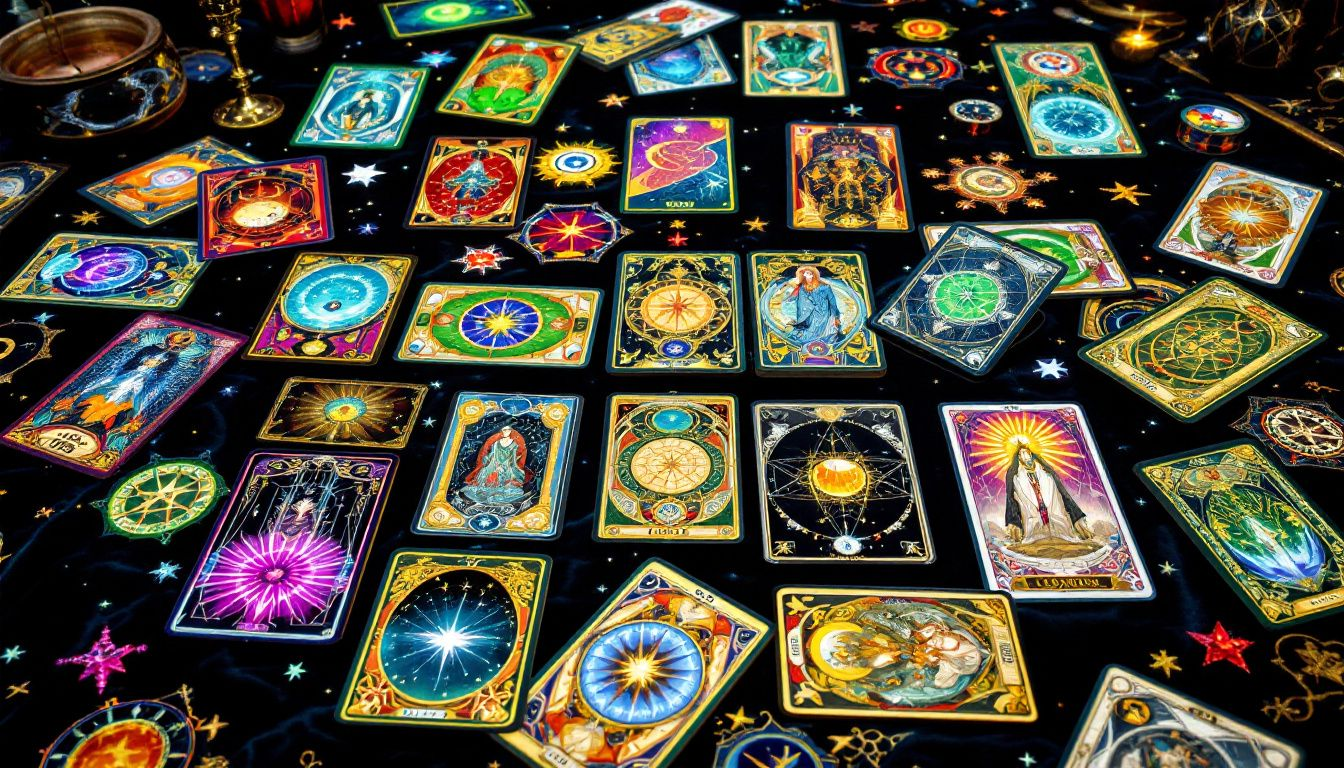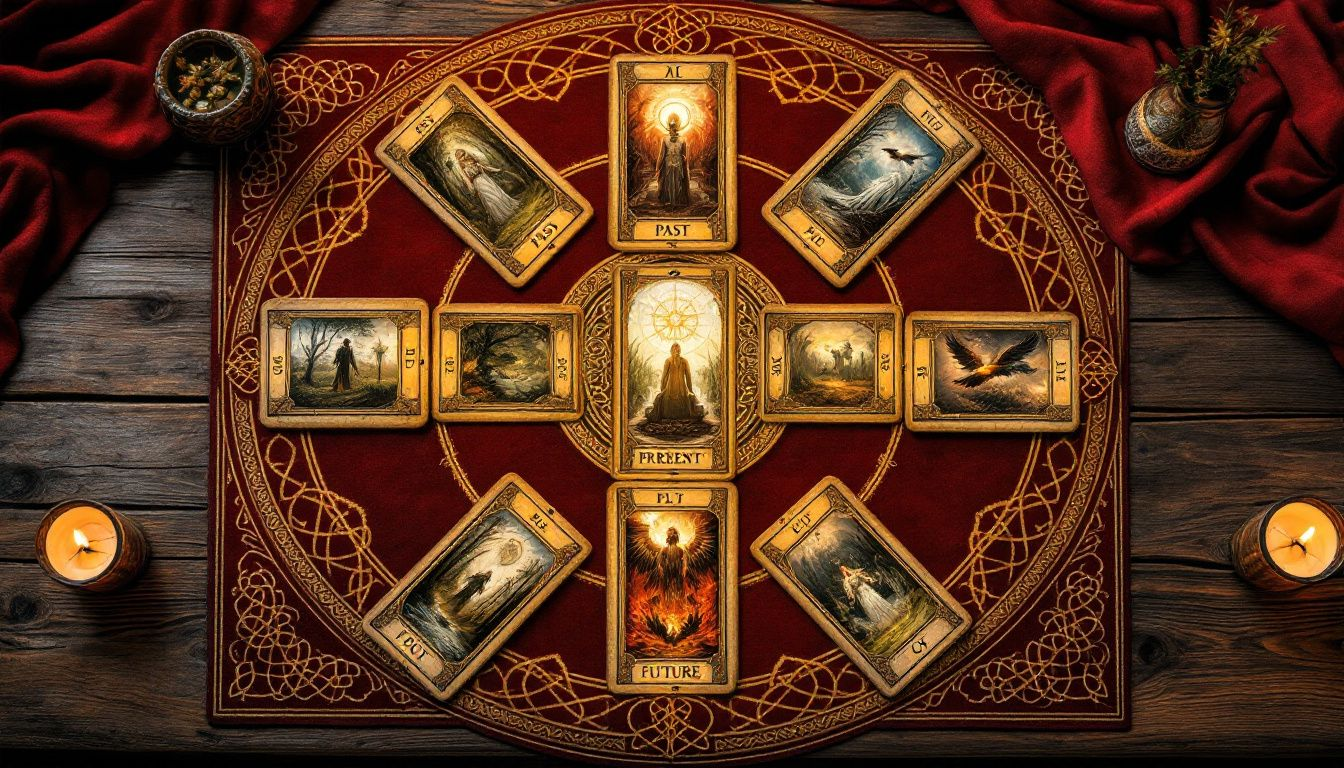Whether you’re new to tarot or looking to deepen your practice, this beginner's guide to tarot provides the knowledge you need to use tarot cards effectively. This article covers essential meanings, popular spreads, and tips for getting the most out of your tarot readings. Let’s dive in and explore the world of tarot together.
Key Takeaways
-
Tarot cards consist of 78 cards divided into Major Arcana (22 cards) for significant life events and Minor Arcana (56 cards) for daily experiences across four suits.
-
Choosing a tarot deck should be a personal and intuitive process, focusing on aesthetic and emotional resonance to enhance your readings.
-
Using various tarot spreads, like the three-card spread and the Celtic Cross, helps structure readings and provides deeper insights into specific questions or situations.
The Ultimate Tarot Guides: Meaning, Spreads, and Tips

Tarot cards act as a reflection of our deeper selves, offering insights into significant events and day-to-day occurrences. The Major Arcana is comprised of 22 tarot cards that represent critical life lessons and spiritual knowledge. Each card holds its own unique meaning and is instrumental in guiding individuals through the major transitions in life during a tarot reading. The 'death card,' for instance, symbolizes transformational change rather than physical death, and should be viewed as an opportunity for positive change and personal growth. In contrast, the Minor Arcana consists of 56 cards which depict everyday life situations spread across four suits: wands, cups, swords, and pentacles—each suit corresponding to different aspects of human experience.
Understanding upright and reversed meanings can provide a more layered interpretation during readings, lending subtlety and depth to the understanding garnered from each card. Tarot readings are shaped by the layouts used when arranging the cards.
The method employed for laying out tarot cards can be adapted based on specific inquiries or purposes—from applying straightforward three-card spreads that shed light on past influences, present circumstances, and impending future developments, to employing an elaborate Celtic Cross spread for comprehensive guidance. Establishing personal ties with your deck through practices like meditation or keeping a journal may amplify your capacity to discern what each tarot card signifies within reading.
Introduction
In our quest for insight and direction, tarot cards present a distinctive avenue to access the innermost corridors of wisdom and delve into life’s various chapters. Originating as a card game in the 15th century before being repurposed for divination purposes in the 18th century, tarot has since evolved into an intricate art form with numerous layers. Currently enjoying widespread popularity, it serves as a conduit for individuals to investigate their spiritual path, gain psychological understanding, and express themselves artistically.
The act of mastering tarot resembles setting forth on an odyssey that demands dedication, eagerness to learn, and receptiveness to altered viewpoints. Immersing yourself in the nuanced meanings and imagery embedded within the cards may lead you towards illuminating revelations about your personal journey and specific situations. It is through this incremental learning process that you forge deeper connections with your innate intuition while acquiring guidance underscored by interpretative skillfulness.
Creating a sacred atmosphere dedicated solely to performing readings can amplify focus and spark creative energy during one’s practice with tarot. Simple rituals like lighting candles or accentuating your space with aesthetically pleasing fabrics or crystals serve not only practical functions but also assist in cultivating serenity conducive to centered contemplation.
This fundamental guide clears up any ambiguity surrounding tarots’ use by presenting succinct interpretations of each card’s significance along with arrayed layouts—and hands-on advice—to usher you confidently onto this intriguing passage anchored upon discovery driven by fervor-filled curiosity.
Understanding Tarot Cards

The essence of tarot is encapsulated in a collection of 78 cards, each abundant with symbolic significance. This deck splits into two primary categories: the Major Arcana and the Minor Arcana.
Comprising 22 cards, the Major Arcana symbolizes pivotal events and deep spiritual teachings that assist readers on their journey through critical life transitions.
Conversely, there are 56 cards in the Minor Arcana, which are organized into four distinct suits:
-
Wands
-
Cups
-
Swords
-
Pentacles
Each suit represents various elements and experiences encountered in everyday life.
For insightful readings and powerful interpretations to occur, developing a profound rapport with your tarot deck is essential.
Major Arcana Explained
Comprising 22 cards, the Major Arcana is essentially the core of a tarot deck, embodying pivotal life occurrences and spiritual teachings. These specific cards within the arcana are each imbued with their own distinct significance and epitomize particular archetypes or principles that steer people on their paths through life.
Embarking from The Fool, which depicts initial steps and untapped possibilities, to culminating at The World card—indicative of culmination and satisfaction—the Major Arcana provides deep understanding into an individual’s journey towards personal development and awakening.
Minor Arcana and Their Suits
The Minor Arcana is comprised of 56 cards and segregated into four distinct suits, each illustrating various elements of life.
-
Wands are indicative of activity and inventive expression, typically linked to one’s profession and personal endeavors.
-
Cups pertain to emotional states and interpersonal connections, shedding light on our internal emotive realm as well as our relationships with others.
-
Swords represent the struggles and hurdles we face, primarily tied to cognitive processes and communicative actions.
Every suit encapsulates a different segment of day-to-day existence.
With a concentration on intellectual pursuits and conversation skills, swords underscore conflicts needing mental acuity for resolution. Meanwhile, Pentacles focus on tangible matters related to finances or health issues—essentially outlining our material existence alongside physical possessions. The array within each suit encompasses 14 cards that include numerically sequenced items. To four courtly figures. This ensemble provides an exhaustive representation of common experiences as well as social exchanges.
Choosing Your First Tarot Deck

Choosing your initial tarot deck is a deeply personal and intuitive decision. Procuring your own deck is essential for personal exploration and developing your intuition. It’s crucial to select a deck with which you feel a profound resonance, as this connection will amplify the quality of your readings. Seek out designs that stir powerful emotional reactions within you since the visual appeal can greatly influence both your engagement with and interpretation of the cards. For novices, the rider waite deck is commonly suggested for its clear symbols and status as a foundational reference point for numerous contemporary tarot decks.
The market is flooded with an array of tarot decks, boasting unique indie versions featuring distinctive artistic flair, ensuring there’s something that aligns with everyone’s aesthetic tastes and intuitive preferences. Keep in mind, each tarot deck comprises 78 cards split into two segments: The Major Arcana—symbolic of transformative life events—and the Minor Arcana—which depicts day-to-day happenings.
Devote ample time to peruse various choices until you find a deck that truly seems suited to you.
How to Read Tarot Cards
The practice of reading tarot cards is a journey into personal insight and an exercise in self-care. A tarot guide can help navigate the diverse interpretations and criticisms of tarot readings. It’s crucial for newcomers to the world of tarot to keep an open mindset and embrace a step-by-step learning process. To embark on this path, select a tarot deck that strongly appeals to you on a personal level. Rather than striving to commit every individual card meaning to memory, concentrate on comprehending the narrative each card presents as it pertains to your specific inquiry or circumstance.
Engaging in tarot readings enables one’s sense of agency instead of forecasting rigid outcomes. It empowers individuals by providing deep insights with which informed life choices can be made. Utilizing various tarot spreads—arrangements used when laying out the cards during a reading—enhances interpretive clarity by illuminating how different cards relate to one another. Established common spreads offer organized methods for tackling readings, thereby aiding practitioners in narrowing down their concentration towards distinct inquiries or facets of life.
Preparing for a Reading
To conduct a tarot reading effectively, it’s important to carry out specific preparatory steps that help secure concentration and precision. It is imperative to purify the tarot deck by expelling any residual energies from past readings, which can be accomplished through shuffling the cards, smudging them with herbaceous smoke or encircling them with gemstones.
Creating a consecrated area helps in sharpening intention and focus. For instance, unfolding an ornate fabric beneath the tarot cards or igniting a candle could facilitate mental clarity while attracting creativity. Arranging stones in a ring-like pattern around your deck may also amplify the energetic atmosphere of your reading space and sustain its purity energetically.
For those who perform readings regularly, implementing daily rituals aimed at energy cleansing enhances their capacity for tuning into guidance and harnessing intuition. These habitual practices set up an ideal setting that augments depth as well as accuracy within every tarot card interpretation provided during sessions.
Interpreting Single Card Draws
Drawing a single card from your tarot deck is a potent method to obtain quick insights and guidance for each day. When you pull a card, you can concentrate on its unique message, offering precise and straightforward understanding relevant to the situation at hand. Employing this approach is exceptionally beneficial for brief readings or when seeking clear direction on a particular matter.
This technique serves as an effective instrument for daily contemplation and making choices.
Using Three Card Spreads
Utilizing a three-card spread is commonly employed to reflect on the timeline of a circumstance, linking past events, current status, and prospective future developments. Pulling three cards sequentially aids in understanding how historical factors influence present conditions and possible future scenarios.
The layout provides an organized viewpoint that enhances comprehension and provides direction by constructing a story-like sequence.
Popular Tarot Spreads

During a tarot reading, utilizing diverse tarot spreads is critical for the arrangement and interpretation of the cards. Renowned spreads range from the simplistic single card draw to more elaborate setups like the three card spread or the intricate Celtic Cross spread, each designed to fulfill specific objectives such as delivering prompt enlightenment or detailed understanding of complex circumstances.
To amplify your experience with tarot practice and secure guidance that caters specifically to individual requirements, it’s beneficial to gain proficiency in applying an array of different spreads.
The Celtic Cross Spread
The Celtic Cross tarot spread is notably recognized and extensively practiced for its methodical technique in unraveling the intricate aspects of a situation. It offers detailed perceptions through an arrangement that consists of six cards shaped as a cross coupled with four additional cards aligned vertically. Each card within this ten-card layout embodies specific significance, addressing various elements from current circumstances to possible future events.
In the sequence of positions within the Celtic Cross, the initial spot denotes what presently surrounds an individual or matter at hand, while the subsequent position unveils challenges or assisting factors influencing one’s context. The third slot delivers insight into historical occurrences that have molded today’s scenario by revealing past experiences.
Occupying tenth place in this system and portraying prospective conclusions is a card which serves as a signpost towards how things may evolve or reach closure concerning issues under scrutiny.
Other Common Spreads
Numerous tarot spreads beyond the Celtic Cross are favored for their distinct perspectives. The Seven Card Horseshoe Spread evaluates the influences of past, present, and future on a particular circumstance, offering an all-encompassing summary.
Another adaptable configuration is the Five Card Spread which permits readers to concentrate on precise facets of a scenario through examining five separate areas. These layouts provide assorted methods for conducting tarot readings that accommodate various inquiries and requirements.
Working with a Tarot Reader
Working with a tarot reader can be a powerful way to gain insight and guidance in your life. Here are some tips to keep in mind when working with a tarot reader:
-
Be Open-Minded and Receptive: Approach the reading with an open heart and mind. Trust the reader’s interpretation of the cards, even if it challenges your current perspective.
-
Ask Clear and Specific Questions: Formulate your questions clearly to help the reader focus their reading. Specific questions yield more precise and actionable insights.
-
Honesty and Authenticity: Be honest and authentic in your communication with the reader. The more genuine you are, the more accurate and helpful the reading will be.
-
Take Notes and Reflect: Jot down key points during the reading and take time afterward to reflect on the insights. This helps integrate the guidance into your life.
-
Choose the Right Reader: Consider working with a reader who uses a deck that resonates with you, such as the Rider-Waite deck. Their experience, reputation, and style are also important factors to consider.
When choosing a tarot reader, consider their experience, reputation, and style. Some readers may specialize in specific areas, such as relationships or career guidance. Be sure to ask about their approach and what you can expect from the reading. This ensures you find a reader who aligns with your needs and preferences.
Tarot for Personal Growth and Self-Discovery
Tarot can be a powerful tool for personal growth and self-discovery. By working with the cards, you can gain a deeper understanding of yourself and your place in the world. Here are some ways to use tarot for personal growth:
-
Explore Strengths and Weaknesses: Use the cards to identify your strengths and areas for improvement. This self-awareness can guide your personal development journey.
-
Reflect on Symbolism and Imagery: Delve into the symbolism and imagery in the cards to gain insights into your thoughts, emotions, and behaviors. This can reveal hidden aspects of yourself.
-
Practice Self-Reflection and Journaling: Keep a tarot journal to document your readings and reflections. This practice helps you track your progress and integrate the insights into your life.
-
Set Intentions and Manifest Change: Use the cards to set intentions and manifest positive changes. The guidance from the cards can help you focus your energy on achieving your goals.
-
Popular Spreads for Personal Growth: Consider using spreads like the Celtic Cross spread and the Ten Card Spread. These layouts provide comprehensive insights into your personal journey and help you understand your place in the world.
By incorporating these practices into your tarot readings, you can use the cards as a powerful tool for personal growth and self-discovery.
Developing Intuition and Personal Connection
Fostering a strong personal connection and honing your intuition are essential for delivering meaningful tarot card readings. It is often recommended by experienced readers to bond with a single deck that resonates deeply with you instead of collecting multiple decks. Start by getting acquainted with each card in the tarot deck, recording initial feelings, and cultivating a rapport. Incorporating meditation and mindfulness techniques can bolster your inner voice’s clarity, thereby enhancing intuitive skills.
In the practice of tarot reading, it is vital to trust in your own intuition, which allows for interpretations that transcend traditional definitions. To assist in recognizing recurring motifs and boosting confidence in your interpretive abilities, maintain an extensive journal detailing both readings conducted and insights gained from relying on intuition.
Consistent engagement with the cards through daily draws or employing imaginative visualization can enrich one’s comprehension of their meanings while also reinforcing intuitive connections. Ensuring regular purification of your tarot deck aids in preserving precision and sharpness during sessions of divination.
Advanced Tips for Tarot Readers

Individuals aiming to probe a bit deeper into the realm of tarot can benefit from adopting advanced techniques that enhance their practice. Applying a nine-card square spread offers an opportunity for layered readings, delivering perspectives through distinct amalgamations of card placements.
Introducing supplementary clarifying cards, by drawing extra tarot or oracle cards, may present Profound insights within your readings. Such refined strategies improve your comprehension and intuition, facilitating intricate interpretations.
Common Tarot Mistakes to Avoid
As a beginner, it’s easy to make mistakes when working with tarot. Here are some common mistakes to avoid:
-
Taking the Cards Too Literally: Remember that tarot is a symbolic language. Avoid interpreting the cards too literally and focus on the broader message they convey.
-
Not Asking Questions or Seeking Clarification: Don’t hesitate to ask questions or seek clarification from the reader. This ensures you fully understand the insights being offered.
-
Getting Attached to Specific Outcomes: Tarot is a tool for guidance, not prediction. Avoid getting too attached to specific outcomes or predictions and remain open to the guidance provided.
-
Neglecting Reflection: Take time to reflect on your readings and integrate the insights into your life. This practice enhances the value of the guidance received.
-
Not Experimenting with Decks and Spreads: Don’t be afraid to try new decks and spreads. Experimentation is key to finding what works best for you and deepening your understanding of tarot.
By avoiding these common mistakes, you can get the most out of your tarot readings and use the cards as a powerful tool for personal growth and self-discovery. Proper shuffling, clear questions, and an open mind are essential for accurate and meaningful readings.
Maintaining and Caring for Your Tarot Deck
Taking good care of your tarot deck is vital for preserving its utility and lifespan. It’s important to shield your tarot cards from any liquid damage, so always keep them in a secure place far from spills and moisture. Employing a special cloth or pouch dedicated to the tarot can maintain the cleanliness and sanctity of your deck during readings. When your tarot cards become excessively worn out or suffer irreparable damage, it’s fitting to dispose of them respectfully through methods like burial or cremation as a tribute to their service.
To ensure that stale energies are removed and the clarity of the deck is preserved, engaging in periodic cleansing rituals can be very beneficial. Techniques such as encircling the deck with crystals, shuffling it thoroughly, or passing it through herbal smoke contribute greatly towards rejuvenating the energy surrounding your cards. Adhering to these practices will help sustain your tarot as an effective instrument for perceptive readings.
Summary
To summarize, tarot cards provide a distinctive and profound method for delving into one’s psyche and obtaining direction along life’s path. Grasping the significances of both the Major and Minor Arcana, selecting a deck that harmonizes with your essence, and committing to frequent readings constitute key milestones in becoming proficient at tarot. By honing your intuition and looking after your deck attentively, you can guarantee readings that are both significant and precise. Embark on this voyage with confidence, heed your inner insights, and allow the wisdom of tarot to steer you forward.
Frequently Asked Questions
How do I choose my first tarot deck?
Choose a tarot deck that resonates with you emotionally, and consider starting with the Rider Waite Smith deck since it’s well-loved for its clear imagery and solid foundation for beginners.
Trust your intuition!
What are the Major Arcana and Minor Arcana?
The Major Arcana includes 22 cards that symbolize major life events and spiritual lessons, while the Minor Arcana has 56 cards across four suits representing daily experiences.
So, if you’re diving into tarot, these distinctions help guide your understanding!
How can I improve my tarot reading skills?
To improve your tarot reading skills, make it a habit to practice daily card draws, meditate, and keep a tarot journal.
This regular engagement will boost your intuition and help you connect more deeply with the cards.
What are some common tarot spreads?
Some common tarot spreads are the single card draw for quick insights, the three card spread for past, present, and future guidance, and the Celtic Cross for a more detailed analysis of your situation.
Each spread offers a unique perspective, so choose one that resonates with your question!
How should I care for my tarot deck?
To keep your tarot deck in great shape, protect it from moisture and use a tarot cloth to keep it clean.
Regularly cleansing your cards will also help maintain their clarity and effectiveness.







